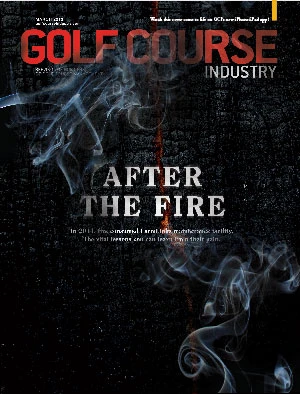 Jeffrey D. Brauer Jeffrey D. Brauer |
In 2008, I reviewed several aspects of bunker construction, from style, to drainage to liners. At that time, I covered two basic groups of bunker liners – Fabrics and Hard Surfaces/Soil Binders. I received a few letters wondering why I didn’t discuss the “Billy Bunker.” The reason was that I hadn’t used them personally yet, and didn’t feel comfortable opining on them. Now, I have several courses with bunkers under re-construction with the “Better Billy Bunker” method, including a bunker renovation at Cowboys Golf Club near Dallas, where I originally designed very steep bunkers and where we get some very heavy rain. The early results have been impressive. Ed Easley, EAGL’s construction coordinator in charge of the project says, “We have tried every bunker liner known to mankind….this is the ‘silver bullet’ of bunker lining.” As I wrote in 2008, I intuitively believe a hard surface liner should be superior to fabric liners, primarily because fabric liners eventually tear and require replacement. However, my experience with hard materials on native soils is that they are prone to cracking, much like non-reinforced concrete. At least, that is my experience here in the shrink-swell soils of Texas. Those problems make the idea of the Better Billy Bunker method interesting, since its “sticky gravel” method conceptually splits the difference between the hard and soft layer methods. It may be the best of both worlds, although I suppose cynics could claim it’s also the worst of both worlds. The key defining feature is the 2-inch layer of clean gravel, coated with a specialized polymer spray, which is essentially a plastic. It seeps down through the gravel to harden it into a strong-but-flexible surface. This allows water to drain straight through quickly – up to 400 inches per hour, enough for all but rains of biblical proportion. This drainage reduces the erosive forces on the sand surface because the major water movement is 2 inches below it. Wet sand is heavier and more prone to slump. In addition, the spray coating reduces the gravel’s porous openings enough to minimize sand migration down and soil migration up. You do need to test the sand and gravel to make sure your two materials adequately “bridge” much like the requirements for a USGA green. Installation cost using one of the “licensed” Better Billy Bunker installers (which is required) for the polymer is similar to fabrics, ranging from $1.50-$1.75 per square foot. However, there is additional cost to procure the gravel, which can vary by locale, so your costs might vary. Here in Dallas/Fort Worth, gravel costs from $23-$32 per ton, (and fuel costs are doing nothing but increasing gravel prices) adding about $0.30 to the cost, making it slightly more expensive. You will likely spend about $25,000 more on the Better Billy Bunker – always a tough choice in difficult economic times and on major projects. Like the other methods, we are not sure of longevity, but the first installation of the Better Billy Bunker was eight years ago, and it’s still in good shape, according to the company. However, this product should last at least as long as other methods. After all, what lasts longer than gravel and plastic? It probably will last longer. Even with minor damage from soil shifting, it should be easy to repair small sections as required, similar to other hard surface liners. Has this product changed my advice to superintendents looking to renovate problem bunkers? Well, yes, because it is impressive. And, no, because I have always urged a three part decision-making process. Therefore, my first advice is to use a bunker liner, any bunker liner. I know without them, your bunkers will likely be a mess in a few short years. Bunkers liners have trickled down from the top clubs to become “standard” at all but the poorest courses. The decision has morphed from “whether to use liners” to “which liner to use.” Second, test them all in your conditions. I’ve used them all and each works, but you need to evaluate them in terms of your unique conditions. You’ll have lesser need if in the desert rather than in Houston. If one method works best in your tests, use it, rather than one that doesn’t work well to save a few thousand dollars up front. Third, consider the longer term, including life cycle and daily labor costs, rather than only initial construction cost. It’s easier to machine rake the Better Billy Bunker, if that is important to you. To be fair, newer, stronger bunker liners can also be raked, if carefully, than earlier products. Add in unscheduled sand shoveling after big rains, and the annual labor savings quickly and easily outpace the annual loan cost on initial construction. At some point, you will need to budget for $150,000 in bunker liners. Certainly, the old adage is you never skimp on your greens because of their importance. If bunkers now cost as much or more than greens to maintain, then the same adage applies. I urge you to pick the best product for your needs, regardless of cost. |

Explore the March 2013 Issue
Check out more from this issue and find your next story to read.
Latest from Golf Course Industry
- From the publisher’s pen: Conscientious of a bigger role
- Bernhard and Company partners with Laguna Golf Phuket
- Terre Blanche showcases environmental stewardship
- VIDEO: Introducing our December issue
- Bernhard and Company introduces Soil Scout
- Nu-Pipe donates to GCSAA Foundation’s Centennial Campaign
- GCSAA enhances golf course BMP tool
- Melrose leadership programs sending 18 to 2026 GCSAA Conference and Trade Show





